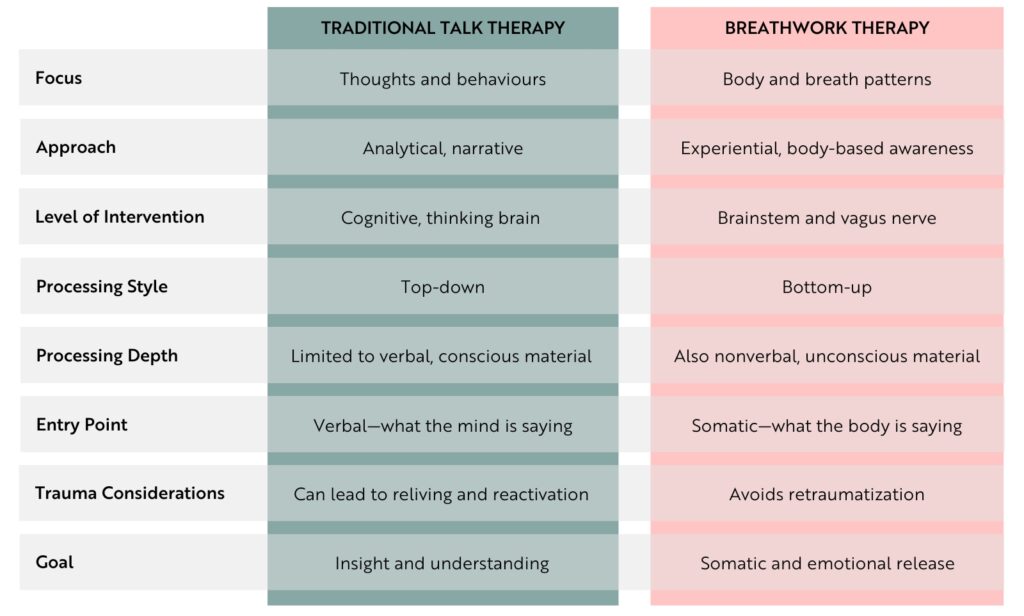Because Sometimes Healing Begins With a Single Breath
You hold it together all day—until your body says otherwise.
Maybe you don’t notice it at first. Just a tight chest. A held breath. A lump in your throat that never quite goes away.
You’ve done the journaling, the therapy, the yoga. But something still feels stuck. Deep. Wordless.
That’s where breathwork begins.
This isn’t just about deep breathing. It’s about helping your nervous system finally let go—without having to explain or analyze it.
Breathwork offers a direct pathway to release what your body has been holding—so you can breathe freely again.
Sometimes the most powerful healing doesn’t come through words—but through your breath finding its rhythm again.
What is Breathwork Therapy?
Breathwork is a body-centered therapeutic practice that uses conscious breathing techniques to help regulate the nervous system, release trauma, and access deeper states of emotional clarity and calm.
It’s not just about calming down—it’s about waking up parts of you that have gone offline from years of stress, trauma, or survival mode.
Breathwork combines ancient wisdom with modern trauma science. It gives you access to healing that doesn’t require words—just your presence, your breath, and a safe space to surrender.
This is where emotional release meets physiological reset.
Why This Matters
Trauma doesn’t always live in memory.
It lives in breathless moments, silent tension, and survival held in the body.
-
- The shallow breath of anxiety
- The tight jaw of suppressed anger
- The breath you’ve held since the day it all changed
Breathwork bypasses the mind and speaks directly to your nervous system.
This approach is especially effective for:
-
- Emotional overwhelm or chronic anxiety
- Trauma that feels hard to verbalize or remember
- Feeling “numb” or disconnected from your body
- Panic, grief, or rage that feels stuck in the chest or throat
- Burnout, fatigue, or stress you can’t seem to shake
- Clients who’ve plateaued in talk therapy and need something deeper
Because healing isn’t always cognitive—it’s often cellular.
You don’t have to understand it all. Sometimes your body just needs a chance to exhale.
How Does Breathwork Affect Mental Health?
Breathwork serves as a powerful bridge between the mind and body, offering profound therapeutic benefits for various mental health conditions.
Breathwork gently shifts your body out of survival mode. It helps regulate the nervous system, lower stress hormones like cortisol, and boost oxygen flow to the brain — creating the conditions for calm and clarity. By learning to work with your breath, you gain access to a powerful inner tool for managing anxiety, depression, and the lingering effects of trauma.
Breathwork also activates the parasympathetic nervous system and helps release stored energy or trauma through controlled breath patterns. The process is gentle but powerful.
Here’s what a session may include:
-
- Guided breathing techniques tailored to your needs (e.g., connected breath, three-part breath)
- A quiet, attuned space to access emotion and somatic awareness
- Nervous system regulation tools to anchor safety
- Music or gentle touch (with consent) to deepen presence
- Space to process or integrate afterward—verbally or somatically
This isn’t about forcing anything. It’s about creating space for what’s ready to move.
What Makes Breathwork Different from Talk Therapy
While talk therapy engages the thinking mind, breathwork speaks directly to the body’s survival system—often where trauma hides.

When words fall short, breathwork offers a way through—helping your body release what your mind can’t always explain.
Breathwork gives you access to healing that lives beyond words—and offers peace your body can finally trust.
Types of Breathwork Practices We Use
Breathwork isn’t one-size-fits-all. It’s a versatile and adaptive tool, offering different techniques to meet you at different stages of your healing journey. Some practices are gentle and grounding, ideal for calming the nervous system and restoring balance. Others go deeper, helping to release stored emotions, clear energetic blockages, and reconnect you with parts of yourself that may have gone quiet.
Knowing the distinction can help you understand what kind of breathwork best suits your needs — whether you’re seeking calm, clarity, or catharsis.
Breathwork for Nervous System Regulation
These practices are slow, steady, and stabilizing. They support your body’s natural ability to shift out of fight-or-flight mode and return to a state of rest, regulation, and safety. They’re especially supportive for anxiety, chronic stress, burnout, or when you feel emotionally “off-center.” Many clients start here, learning how to work with their breath as a tool for grounding and self-regulation.
Techniques we may use include:
- Diaphragmatic Breathing: activates the parasympathetic nervous system and deepens the breath
- Box Breathing: promotes calm and focus through structured breath patterns
- Coherent Breathing: balances heart rate variability and improves emotional regulation
- Pranayama Breathing: ancient yogic techniques that support physical and energetic balance
Breathwork for Emotional Release & Trauma Healing
Once a foundation of safety is established, we may explore deeper, more expansive breathwork practices designed to access the emotional and somatic layers of your experience. These techniques use connected, rhythmic breathing to help release stored emotions, unprocessed trauma, and habitual tension. They can be intense, but also deeply freeing — helping you uncover what’s been buried, and make space for something new.
Techniques we may use include:
- Holotropic Breathwork: developed to access non-ordinary states of consciousness and deep inner healing
- Transformational Breath: integrates breath, movement, sound, and affirmations to release emotional blocks
- Somatic Breathwork: guided breath designed to release emotions held in the body’s tissues
- Wim Hof Method: combines breath retention and cold exposure to build resilience and nervous system flexibility
Each practice is offered with care, attunement, and respect for your pace. Together, we’ll choose the approach that feels most supportive for where you are — and where you’re ready to go.
Breathwork teaches you how to harness the power of your breath to manage stress, release stored emotions, process trauma, and reconnect with your self.
Who Breathwork Is For
Breathwork may be right for you if:
-
- You feel emotionally stuck or shut down
- You struggle with anxiety, panic, or chronic stress
- You’ve tried talk therapy but feel disconnected from your body
- You want to explore healing through sensation and experience
- You carry trauma you can’t fully name or explain
If your body feels like it’s holding something you can’t quite reach, breathwork may be the key.
The Outcome: What Clients Experience
Clients often describe profound shifts after breathwork, including:
-
- A feeling of “lightness” or release
- Emotional clarity without needing to talk it out
- Reduced anxiety or panic responses
- Greater connection to their body and intuition
- Feeling calm, grounded, and deeply present
This is healing that moves through the breath—and lasts in the body.
After breathwork, I didn’t just feel relaxed. I felt whole—like I had finally come back to myself.
Meet Our Breathwork Practitioners
Our team includes trauma-informed therapists and breathwork facilitators trained in nervous system care, somatic healing, and integrative trauma therapy. Many also offer modalities like IFS, EMDR, and somatic psychotherapy.
Whether you’re new to body-based work or seeking something deeper, we meet you with compassion, skill, and safety.
Below are just a few of our friendly faces, and you can learn more about us on Our Team page.

We’re here to help you breathe easier—in every sense of the word.
Our Locations: Toronto, Richmond Hill & Vaughan
We offer breathwork at our Toronto,Richmond Hill and Vaughan locations, providing in-person guidance for deep healing. For those throughout the province, we also provide virtual breathwork therapy across Ontario, so you can access this transformative practice wherever you are.
You deserve support that meets you where you are—physically and emotionally.
Healing doesn’t need to be hard. Sometimes, it starts with one safe breath in—and one long breath out.
FAQs
What is breathwork and how does it work?
Breathwork is a form of guided breathing that helps regulate your emotions, reduce stress, and process unresolved trauma. By consciously working with your breath, you activate your body’s natural healing abilities.
What should I expect during a breathwork session?
During a session, you’ll be guided through specific breathing techniques by a professional psychotherapist. You may experience physical sensations like tingling, warmth, or a sense of lightness as your body responds to increased oxygenation. It’s also common to encounter a range of emotions, from joy to release, as breathwork can unlock suppressed feelings.
Is breathwork therapy safe for everyone?
Yes, but certain techniques may need to be modified for individuals with specific medical conditions (such as respiratory issues or cardiovascular concerns). Your therapist will guide you through safe, supportive practices suited to your needs.
Can I do breathwork therapy virtually?
Absolutely. We offer virtual sessions anywhere across Ontario, allowing you to practice from the comfort of your home with expert guidance.
Ready to Transform Through Breathwork?
Get in touch. Take the first step toward healing and emotional balance. Schedule a consultation today in Toronto, Vaughan, Richmond Hill, or virtually across Ontario.
Get Matched with a Therapist.
Because finding support should never be as hard as what you’re going through.
